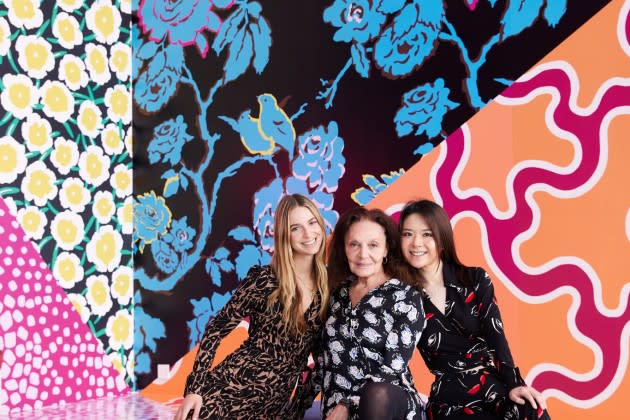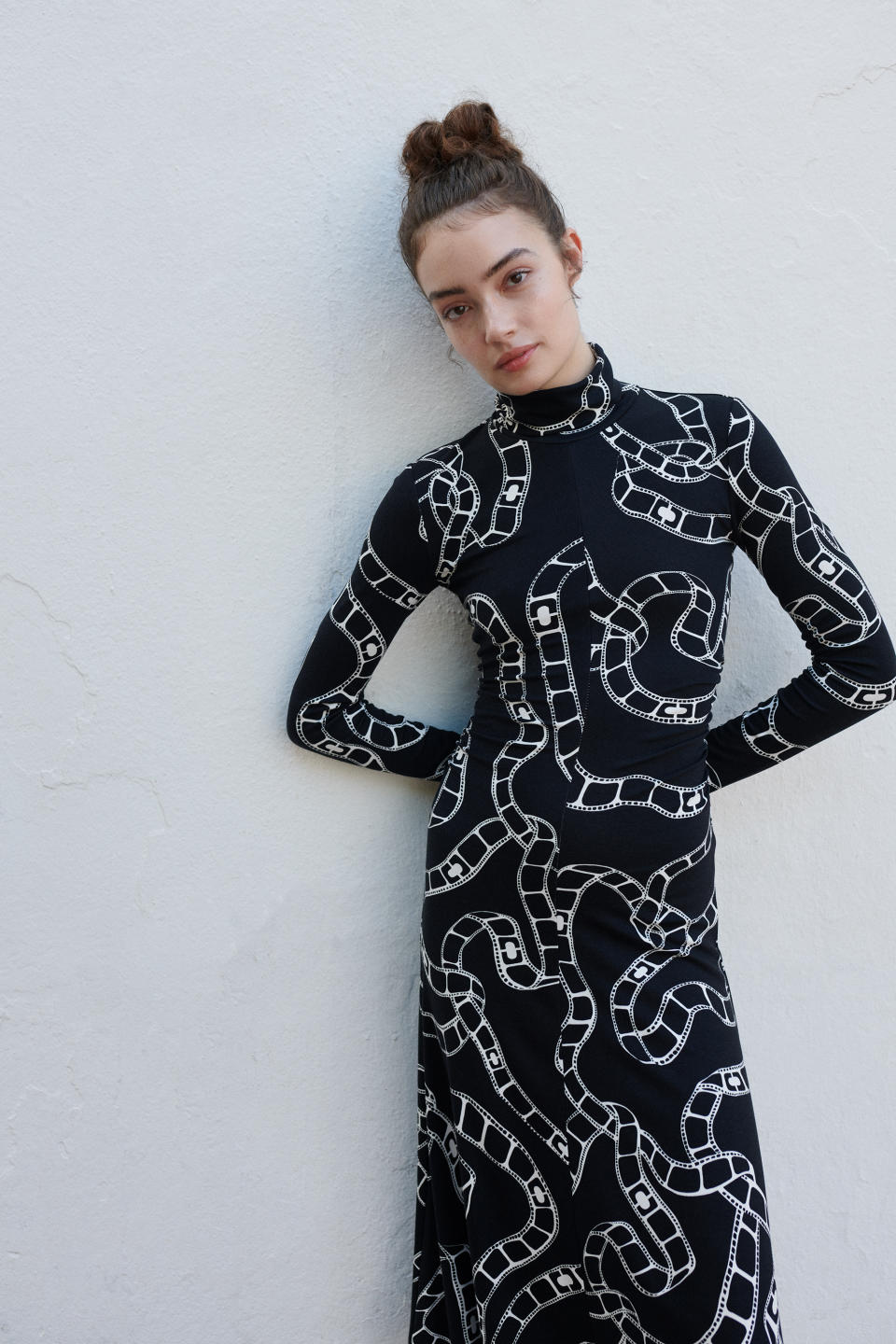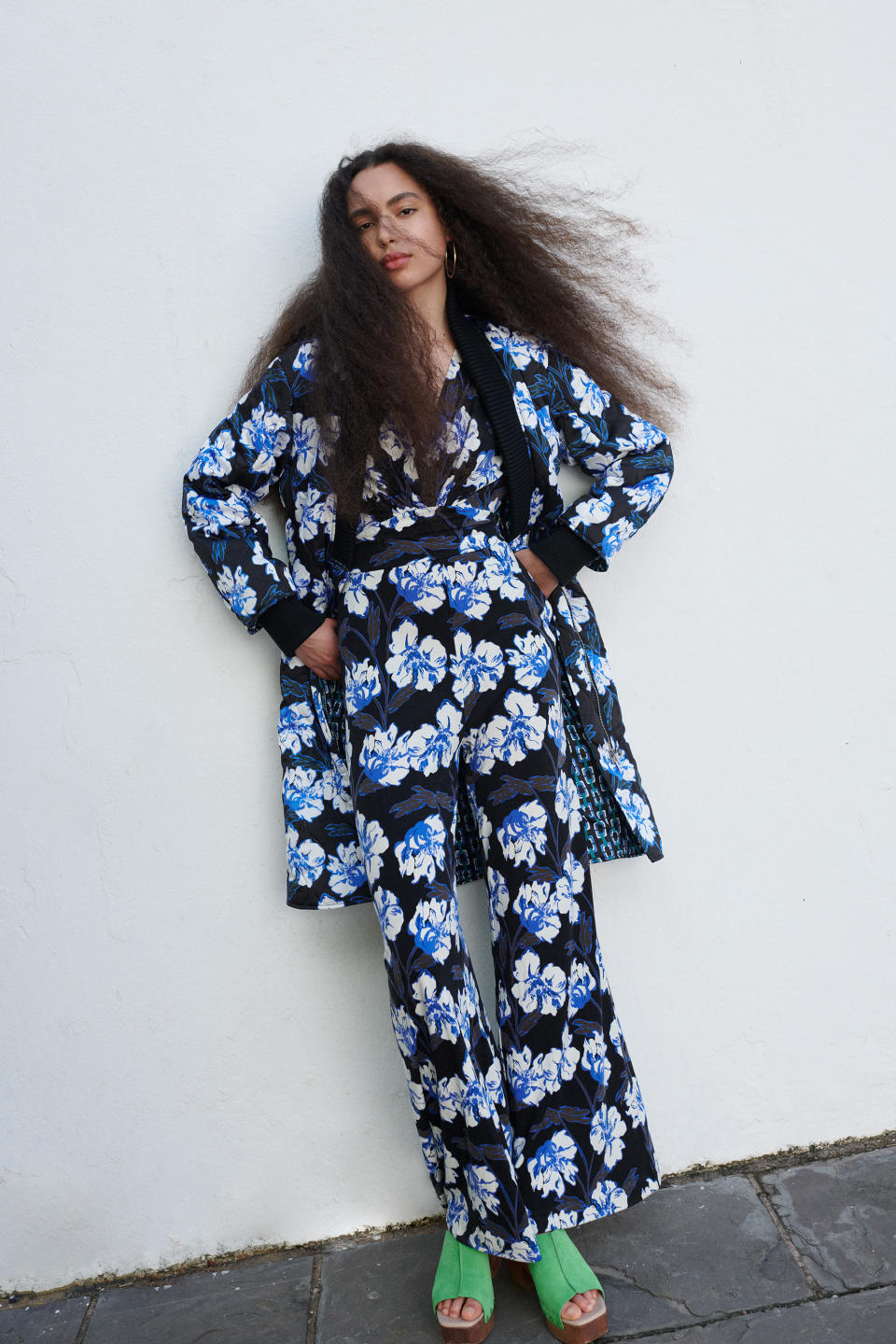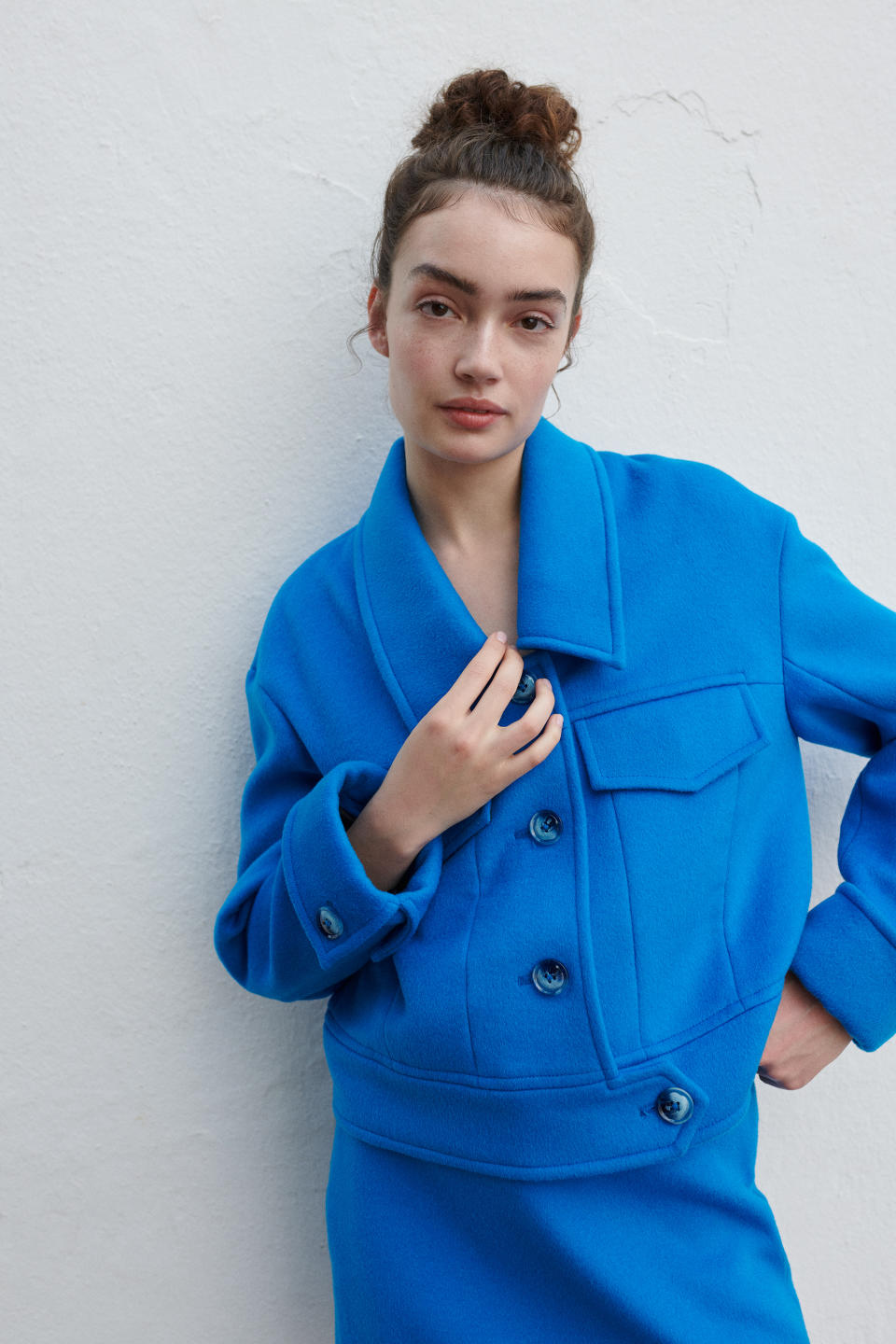Diane von Furstenberg Talks Legacy, Future of the Brand and New Projects
- Oops!Something went wrong.Please try again later.

“We’ve been very quiet since COVID[-19] because of all the things that happened. When COVID[-19] came, I thought to myself, ‘this is a moment to reset the clock,'” said Diane von Furstenberg, chairman and founder of her namesake company, in an interview at her office in Manhattan’s Meatpacking District.
The company was losing money at the time, had too many outlet stores and they had to decide whether to declare bankruptcy or sell the business. “I had offers, but then I would have to relinquish all of the assets, the archives, the trademarks.…I started to make a list of the assets — and my family wouldn’t let me relinquish the assets,” said the 76-year-old von Furstenberg.
More from WWD
She recalled when her children were growing up she would always say, “I have three children — a daughter, a son and a brand. I don’t know that they liked it. A few years ago Alex [her son] was very passionate in a meeting, and said, ‘This brand is my brother.'”
Von Furstenberg said they have since cleaned up the business, closed 12 out of 13 stores in the U.S. and six units in the U.K. and European Union and invested significantly into “taking care of everything and taking care of everybody.” Six additional U.S. stores had been closed between 2016 and 2019.
In October 2020, the brand entered a partnership with Glamel Trading Ltd., a Hong Kong-based firm. They are the operations partner with DVF, which is exclusive to Glamel. Glamel’s China team handles production while its London team is in charge of global e-commerce and wholesale jointly with DVF’s New York team, which handles the design direction, print, social media, public relations and marketing.
DVF has since wiped the slate clean and today only manufactures ready-to-wear, generating $130 million in retail sales. There are no licensing agreements and they are basically rebuilding the brand, which von Furstenberg called “the third rebirth” at the company.

That’s quite a difference from 2014, when at its height the company was generating about $500 million in retail volume. “At that time I felt we should push the accelerator and that’s when we made mistakes. They started to open a lot of outlet stores, and wanted to build, build, build. And then I let [earlier management] do that,” admitted von Furstenberg.
Fast-forward to 2023 and the slimmer business is a lot more focused.
“People involved here have been amazing and did a great job cleaning it up. It has wonderful assets, is completely virgin, is very clean and has a 50-year history. That’s worth a lot,” said von Furstenberg, noting the business isn’t for sale but they are talking to partners for additional help.
“We’re at a new dawn. DVF is at its maximum flexibility in where it can go,” she said.
The new regime is headed by Gabby Hirata, 34, president and chief executive officer, and von Furstenberg’s 23-year-old granddaughter Talita, who is vice chairwoman of the company, both of whom participated in the interview.
Throughout the company’s 50-year history, DVF has only used only two factories. Von Furstenberg recalled that she started as an intern at Manufactura Ferretti in Como, Italy, and learned everything about printing from the owner, Angelo Ferretti. Next door, there was a factory that made stockings. With the advent of pantyhose, that factory went bankrupt and was sold to Ferretti. That factory had tubular knitting machines and they experimented using thicker yarns, and that’s how they invented the jersey, said von Furstenberg. They started to make T-shirts and printed them, and went into polo shirts and shirtdresses.
She explained that she came to the U.S. to visit her then-boyfriend Egon von Furstenberg, and met Giorgio di Sant’Angelo and Stephen Burrows, who designed clothes using jersey. “When I went back, all I could think about was ‘how do I go back to America?’ When I arrived at the factory, all of a sudden, this factory in the middle of nowhere, I thought, ‘Here’s an opportunity,’ and this is what I decided to do. That’s when I started to make my first little dresses,” von Furstenberg recalled.
Egon von Furstenberg came to visit her and they got engaged. “He went to Asia and by the time he arrived, I was pregnant,” she said. They got married, and she launched her business in 1973 in the U.S. In 1974 she created the wrap dress, which catapulted her career.
“The knowledge that I learned in Italy 25 years ago, I brought to China,” she said. She brought that exact machine to China, they sent technical people from Italy to set it up, and that’s the second factory she’s ever been involved with.
During COVID-19, she said she had responsibility to that factory and owed them money. “By then, my biggest client was my Chinese distributor,” said von Furstenberg.
Jessie Chen, who established Glamel in 2020, had been exclusively operating the DVF franchisee business in China from 2011 to the present. The DVF China franchisee business entity, Shanghai Fairywood Co., where Chen is the general manager and cofounder, was established in 2011 and exclusively operates the DVF brand, and has grown the business from one store to 57 stores and expanded the e-commerce business. High Fashion is the factory in China that has been DVF’s supply chain partner for 25 years, and partners with Glamel and DVF to make DVF womenswear.
“It was very important that I continued the relationship with them,” said von Furstenberg.
The DVF flagship is on Tmall Luxury Pavillion and a stand-alone DVF China site will be launched in 2024.
Hirata came to the company in January 2020 as head of business development for the Asia-Pacific region, having previously worked at Jill Stuart, Adeam International and Ralph Lauren. One day in March 2020 she walked into DVF’s office and asked if they could host a small gathering with Chinese influencers at her office and make a “Be Strong Wuhan, With Love From Diane,” T-shirt and show support. They did a livestream video and talked candidly about the difficult times.
“The only reason that I’m bringing this up is that’s when I noticed Gabby — that she was both clever and intelligent, compassionate and business-savvy,” said von Furstenberg. On the livestream, they sold out 150 T-shirts, as well as some selected wrap dresses, with 100 percent of the proceeds going to the Adream Foundation to help elementary schools in Wuhan to sterilize equipment and classrooms against the coronavirus.
Von Furstenberg said she needed someone like Hirata, who would speak Chinese to the factory staff and reassure them, and speak to Chen and reassure her.
Von Furstenberg noted that Hirata had the idea that since everything is made in China, why don’t they get involved with the production and all the other activities there? Hirata said the office in Beijing is like a miniature of the New York headquarters, where there’s a retail team, logistics team, I.T. team, etc. With a strong production background, Hirati spent hours sharing her knowledge with Chen.
Today the global business is one-third online, one-third wholesale and one-third direct-to-consumer.
“The last three years we’ve been very much under the radar,” said von Furstenberg.
The brand sells to Neiman Marcus, Nordstrom, Revolve, Mytheresa, Net-a-porter and Zalando, along with selling plus-size dresses to Dia & Co. They also sell Rent the Runway, where DVF has an 88 percent use rate, said Hirata.
Meanwhile, von Furstenberg has spent a lot of time creating the archive (past styles, images, videos), listing the assets (hundreds of thousands of prints), figuring out why her brand matters, and what it stands for. First of all, she said, they have an iconic dress that has sold for 50 years.
“We have an incredible library of prints, a system. Very often we went off the system. When you hire a new CEO or a new designer, they want to reinvent the wheel. But there is a formula, a very interesting formula that we should go back to,” she said.
“I realize I really have something very desirable,” continued von Furstenberg. “My goal is to put it into the most loving and experienced hands. I am talking to a lot of people, I’m an old woman and have great plans for my philanthropy and doing a think tank and spending more time in Venice,” she said. “It is in very good hands now. I’m welcoming expert partners who are able to come in there and help.”
While she said the company wasn’t for sale, she said she would welcome the expertise of partners to help. “I’m in no rush to do anything.” She said at some point she’ll hire a creative director.
Von Furstenberg said her jersey dresses have become “uniforms for women in charge,” and are friends in a woman’s closet. She contended that in any vintage store in the world, DVF’s dresses are strong sellers.
“It just shows how timeless our pieces are. No matter if it’s a 30-year-old dress, a two-year-old dress, a brand new dress, DVF will be able to stay in your closet and be worn again and again,” added Talita von Furstenberg. “It’s always timeless, effortless and sexy.”
She said they are no longer doing the TVF for DVF line of colorful dresses, rompers and tops which was launched in 2019, but have integrated that spirit into the main line.
As von Furstenberg steps away, she has plenty to fill her time. “My goal is I’m going to give you [Talita von Furstenberg and Hirata] the capsule of the legacy. You guys will take it into the future. I ‘m going to focus on my philanthropy, my women’s work,” she said.
A few months ago von Furstenberg got a call from Nicolas Lor, a curator at the Fashion and Lace Museum in Brussels. He decided that he wanted his first exhibition to be on DVF. “He called me, and I said, ‘Why do you want to do an exhibition on me? In Belgium, you have [Maison] Margiela, Raf Simons, Dries Van Noten, you have so many avant garde designers,’ and he said, ‘what you’ve been doing happens to be so relevant for today. By the time I will open the exhibition it will be even more relevant,'” he told her.
“As an old woman to hear this from a young guy is very flattering,” she said.
She agreed to do it and the exhibition opens April 21. “It’s not a retrospective. He wants it to be, ‘Woman Before Fashion.'”
Lor came to New York, and spent 10 days in the archives in Connecticut. “I was so impressed with him that I introduced him to Rizzoli and he’s also editing a book that will become ‘Woman Before Fashion,'” said von Furstenberg. “Instead of being from me, I find it much more legitimate if it comes from somebody else, especially someone of a young generation.” The book will be published in October.
Von Furstenberg had always wanted to do a documentary on the women she has honored at the DVF Awards, but no network wanted to buy it. Instead, they wanted to do one on her. She finally agreed to do a documentary with Sharmeen Obaid-Chinoy, a Pakistani-Canadian journalist, filmmaker and activist known for her work in films that highlight the inequality women face. After this film, Obaid-Chinoy will direct “Star Wars.” She is the recipient of two Academy Awards, seven Emmy Awards and a Knight International Journalism Award.
“Because it is Sharmeen, and she’s such a feminist, I agreed to do it even though I’m not a producer, I’m not a director. I’m only the subject,” said von Furstenberg.
The documentary will be out next January on Hulu.
“All of these things that are happening of which I’m only the subject made me realize that there is a new phase for the brand, and I’m being very careful [with] whom we associate it. Obviously we’re going to look for more expertise for global expansion and for design,” said von Furstenberg.
In 2020, when DVF launched a 10-year plan, they streamlined the team and the business, including the categories. “We streamlined all categories that didn’t make sense to focus on womenswear,” said Hirati. They also got out of all their licensing agreements.
“Even though we’re a 50-year-old brand, we are completely virgin of all categories,” said von Furstenberg. Right now, all they do is ready-to-wear.
“It allows them to recreate like a start-up, and in the way the world works today, it’s an incredible opportunity. Our brand has a purpose, which is women first. I always focused on the important thing — to give women confidence,” she said. Hirata said they re-platformed on Shopify in 2021, and today have 42,000 customers on dvf.com

“Phase one was streamlining the infrastructure and focusing on sustainable growth. It’s trimming all the fat,” said Talita von Furstenberg.
At the end of phase one, the business is profitable and its operating partners are also profitable. Phase one has finished with 138,000 customers, from global e-commerce customers, retail store customers and wholesale partner customers, and the retail sales volume is around $130 million, said Hirata. “We’re so proud of that achievement, and have never missed a shipment,” she said.
“From 2020 to today is 20 percent revenue growth. For 2023, our goal is a 21 percent increase in revenue from last year,” said Hirata. The goal for e-commerce is 36 percent growth, and there will be strategic reopening of DVF stores in several locations, such as Macao, Hong Kong and, this year, in London. They have 57 stores in China, one store in the Meatpacking District in New York, a store in Belgium, one in Greece, and one in Thailand.

Now they are in Phase 2, which is three years. “Our goal is that by the end of 2025, we want to be back at $200 million” in retail sales, said Hirata.
The DVF business is still owned by the von Furstenberg-Diller family. “Right now we own it, and we had to solidify what it stood for so it could be rebirthed again,” said von Furstenberg.
In 2020, there were 100 employees at New York headquarters and 98 employees in retail positions in the U.S. Now, in the New York corporate office there are 40 employees and there are seven employees in the Meatpacking store. There are 20 employees in London, who handle the global wholesale business, managing four markets a year and appointments each season, as well as wholesale day-to-day operations. In China, the staff grew from 40 to 67 people who are employees of Fairywood Co., as well as 288 retail employees. The company has invested in Beijing’s production team, design team and overall merchandising team, as well as I.T. support for the global operation.
Considering DVF’s close relationship with its Chinese partners, Hirata was asked what impact it would have on the business if the U.S. imposes economic sanctions against China for aiding the Russians in the war against the Ukraine. “We are fortunate to have a trusted partner who has taken care of DVF in China for over a decade. Since that business is an independent entity, from DVF Studio, such an executive order will not have a material impact on the China operation,” she said. China accounts for 44 percent of total net revenue.
“We are a completely separate entity. Whatever happens we’ll deal with it, it’s independent,” von Furstenberg added.
The apparel design and prints originate in New York office, and the New York design team and Beijing design and production team speak daily and partner to produce four collections a year. Offerings were slimmed down from about 400 styles a season to 200 a season.
“Dresses are a big part of it,” said Hirata. She said of the 800 styles a year, 72 percent of dresses are sold at full price at dvf.com. The average price point is $400, the entry-level price point is $350, and the classic silk jersey long wrap dress is about $600 to $700.
Von Furstenberg feels that when they do decide to add licensed products, they will go to firms that match the brand’s philosophy. “We want to go to companies that share the value of the woman first, who are pro-woman and feminist. That is super important. We’re lucky because the trend is going that direction,” she said.
Discussing the top categories they’d be interested in, von Furstenberg said, “Beauty would be the first thing to do because it’s about the woman. All I care about is that we work with people who are experts in their field and share the same value to put the woman first.”
Hirata said some of the styles they have expanded into are outerwear, knitwear and jumpsuits. Half of the fall collection are those product innovations within rtw, such as knitwear and reversible coats. Then there’s the channel expansion and regional expansion in East Asia, South Asia and Australia.
Reaching a younger customer is also a priority. The average age of the customer is 42, and that’s coming down to 38 years old. Hirata said the customer is between 30 and 50 years old, but the brand services customers from their 20s to 80s. “It’s always the very young who find it cool again,” said von Furstenberg.
As for what she wants her legacy to be, von Furstenberg said, “My legacy is that I was lucky to become the woman I wanted to be. My goal in life is making every woman feel that she can be the woman she wants to be. As I leave the business to them, I’m going to focus much more on the legacy. I’m very involved in [the nonprofit organization] Vital Voices. Vital Voices is this incredible population of badass women in 184 countries that make things happen.”
Best of WWD

